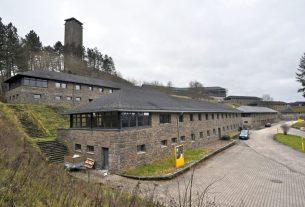The Harz World Forest near Bad Grund is much more than just an arboretum. As the name suggests, several hundred species of trees and plants from all over the world grow in this unique nature park. And it has been for almost 50 years. TRAVELBOOK spoke to district forester Jan-Ole Kropla about his work, the best times to visit and how a hurricane helped create this unusual place.
Anyone who ends up traveling to the small town of Bad Grund in Lower Saxony is likely to rub their eyes in amazement. Instead of the usual image of the forest, you can come across redwoods and other plants on every corner that are not actually native to Germany. And in the Harz world forest you can admire not only California giants, but also a total of several hundred other species. This has existed since 1975, also due to a devastating natural disaster.
The Harz World Forest is home to around 600 species
“We have a sort of open-air museum for trees here,” says Jan-Ole Kropla, who worked as a district forester in the im Harz World Forest it works, at TRAVELBOOK. “The special thing is that we planted them exactly as they are in their natural habitat.” There are trees and plants from North and South America, Europe and Asia. “None are from subtropical and tropical areas,” Kropla explains. “Sometimes in winter we still have temperatures down to minus 20 degrees Celsius, and then they go down.” According to the forester, who manages the more than 1,000 hectare Grund/Weltwald Harz district, there are currently around 1,000 in “his” 600-species kingdom.
The Harz World Forest occupies only 65 hectares of this area, yet requires a lot of maintenance. It has to be constantly cut, mowed, replanted. All so that visitors can admire plants from four continents in their natural habitat along a total of 14 kilometers and different routes. Regions such as the Rocky Mountains, the North American Pacific coast, but also the Himalayas are represented here as faithfully as possible to the original. In addition to the aforementioned redwoods, there are among others tulip, hickory, black walnut and sugar maple trees.
Also interesting: up to 5000 years! The oldest olive tree in the world still bears its fruit
A hurricane of the century gave the impetus to its creation
According to Kropla, the Harz World Forest was created in 1975 both for research purposes and as a tourist attraction. “There have been plans for the area since 1971,” Kropla tells TRAVELBOOK. However, what finally gave the ultimate impetus to the creation of the arboretum was a natural disaster. On November 13, 1972, the storm Quimburg, later known as the hurricane of the century, hit the Harz and uprooted all spruce trees on an area of 20 hectares. “The resulting bare areas were then used to carry out the first plantings.”
This was the initial spark for the Harz World Forest, to which more and more species were added over the years. The location of the area between 200 and 400 meters above sea level is still ideal. “Each species of tree has different needs also in terms of soil conditions and light, we must take this into account.” The highlight, especially for younger visitors, is the almost two kilometer long adventure trail, for which you might definitely need two hours because there is so much to see. “It goes up and down, over a suspension bridge and past various lookout points.” But one of the trails is also barrier-free.
Another interesting thing: these primeval forests are found in Germany and Europe
Flowering and Indian summer
According to forester Kropla, the main attraction of visitors to the Harz World Forest is the flowering of the trees in spring, for which there is even the “Japanese Flower Trail”. Then there’s Indian summer in autumn, when the forest transforms into a colorful sea of colour. Kropla also offers guided tours for students and specialist groups through the Harz World Forest. “Here you literally constantly expand your horizons. Then I still learn a lot about it. Not just on trees, but also on the regions where they originally grow.” Who does not know them can gain new knowledge thanks to several hundred information panels in the forest.

Free entry and no closing times
Anyone who thinks that an attraction like the Harz World Forest requires admission should rejoice: The arboretum is freely accessible to everyone at all times and there are no entrance fees or closing times. Because the forest is not an autonomous complex, but belongs to the normal territory of Kropla. It’s just a little more versatile. And other habitats are already being created in order to always offer visitors something new. For example, a Douglas fir trail is under development. The conifer, which plays an important role in forestry, is not native to Germany but has been around for about 140 years. Among other things, the natural treasure is financed by the state forests of Lower Saxony, where Kropla also works.
Also interesting: the oldest trees in the world
Also of interest: Hoia Baciu: one of the scariest forests in the world
“I applied in writing when the old forester of the district retired. There wasn’t even a job interview and after a few months I was accepted.” Since the forest is open to everyone, there is no measurement of the number of visitors. But in the summer and especially on weekends it can get crowded here. “In winter it’s time to rest, so you can enjoy the solitude in the forest.” Incidentally, the Harz World Forest is not used commercially. “We only rarely sell special timber to carpenters when we have to cut something.”
That nature is the most important thing in the Harz world forest can also be seen from another circumstance. If you come here, you must bring your own food. Here you will find neither gastronomic establishments nor souvenir shops. “But we have many beautiful places in the forest where you can have a wonderful picnic,” Kropla tells TRAVELBOOK. And you can relax and enjoy one of Germany’s unknown natural treasures: a forest where the whole world of plants meets.




